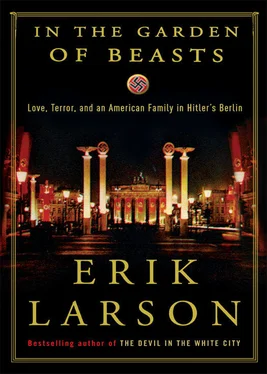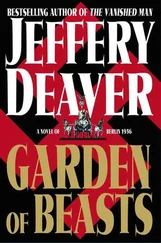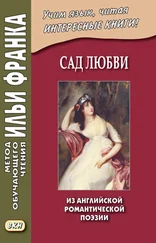Hanfstaengl took a liking to Martha as well but did not think much of her father. “He was a modest little Southern history professor, who ran his embassy on a shoestring and was probably trying to save money out of his pay,” Hanfstaengl wrote in a memoir. “At a time when it needed a robust millionaire to compete with the flamboyance of the Nazis, he teetered round self-effacingly as if he were still on his college campus.” Hanfstaengl dismissively referred to him as “Papa” Dodd.
“The best thing about Dodd,” Hanfstaengl wrote, “was his attractive blond daughter, Martha, whom I got to know very well.” Hanfstaengl found her charming, vibrant, and clearly a woman of sexual appetite.
Which gave him an idea.
Dodd sought to maintain his objective stance despite early encounters with visitors who had experienced a Germany very different from the cheery, sun-dappled realm he walked through each morning. One such visitor was Edgar A. Mowrer, at the time the most famous correspondent in Berlin and the center of a maelstrom of controversy. In addition to reporting for the Chicago Daily News , Mowrer had written a best-selling book, Germany Puts the Clock Back , which had angered Nazi officials to the point where Mowrer’s friends believed he faced mortal danger. Hitler’s government wanted him out of the country. Mowrer wanted to stay and came to Dodd to ask him to intercede.
Mowrer had long been a target of Nazi ire. In his dispatches from Germany he had managed to cut below the patina of normalcy to capture events that challenged belief, and he used novel reporting techniques to do it. One of his foremost sources of information was his doctor, a Jew who was the son of the grand rabbi of Berlin. Every two weeks or so Mowrer would make an appointment to see him, ostensibly for a persistent throat complaint. Each time the doctor would give him a typed report of the latest Nazi excesses, a method that worked until the doctor came to suspect that Mowrer was being followed. The two arranged a new rendezvous point: every Wednesday at 11:45 a.m. they met in the public restroom underneath Potsdamer Platz. They stood at adjacent urinals. The doctor would drop the latest report, and Mowrer would pick it up.
Putzi Hanfstaengl tried to undermine Mowrer’s credibility by spreading a false rumor that the reason his reports were so aggressively critical was that he was a “secret” Jew. In fact, the same thought had occurred to Martha. “I was inclined to think him Jewish,” she wrote; she “considered his animus to be prompted only by his racial self-consciousness.”
Mowrer was appalled at the failure of the outside world to grasp what was really happening in Germany. He found that even his own brother had come to doubt the truth of his reports.
Mowrer invited Dodd to dinner at his apartment overlooking the Tiergarten and tried to clue him in to certain hidden realities. “To no purpose,” Mowrer wrote. “He knew better.” Even the periodic assaults against Americans appeared not to have moved the ambassador, Mowrer recalled: “Dodd announced he had no wish to mix in Germany’s affairs.”
Dodd for his part assessed Mowrer as being “almost as vehement, in his way, as the Nazis.”
Threats against Mowrer increased. Within the Nazi hierarchy there was talk of inflicting physical harm on the correspondent. Gestapo chief Rudolf Diels felt compelled to warn the U.S. embassy that Hitler became enraged whenever Mowrer’s name was mentioned. Diels worried that some fanatic might kill Mowrer or otherwise “eliminate him from the picture,” and claimed to have assigned certain Gestapo men “of responsibility” to stand discreet watch over the correspondent and his family.
When Mowrer’s boss, Frank Knox, owner of the Chicago Daily News , learned of these threats, he resolved to transfer Mowrer out of Berlin. He offered him the paper’s bureau in Tokyo. Mowrer accepted, grudgingly, aware that sooner or later he would be expelled from Germany, but he insisted on staying until October, partly just to demonstrate that he would not bow to intimidation, but mainly because he wanted to cover the annual Nazi Party spectacle in Nuremberg set to begin September 1. This next rally, the “Party Day of Victory,” promised to be the biggest yet.
The Nazis wanted him gone immediately. Storm Troopers appeared outside his office. They followed his friends and made threats against his bureau staff. In Washington, Germany’s ambassador to the United States notified the State Department that because of the “people’s righteous indignation” the government could no longer hope to keep Mowrer free from harm.
At this point even his fellow correspondents became concerned. H. R. Knickerbocker and another reporter went to see Consul General Messersmith to ask him to persuade Mowrer to leave. Messersmith was reluctant. He knew Mowrer well and respected his courage in facing down Nazi threats. He feared that Mowrer might view his intercession as a betrayal. Nonetheless, he agreed to try.
It was “one of the most difficult conversations I ever had,” Messersmith wrote later. “When he saw that I was joining his other friends in trying to persuade him to leave, tears came into his eyes and he looked at me reproachfully.” Nonetheless, Messersmith felt it was his duty to convince Mowrer to leave.
Mowrer gave up “with a gesture of despair” and left Messersmith’s office.
Now Mowrer took his case directly to Ambassador Dodd, but Dodd too believed he should leave, not just for his safety but because his reporting imparted an extra layer of strain to what was already a very challenging diplomatic environment.
Dodd told him, “If you were not being moved by your paper anyway, I would go to the mat on this issue…. Won’t you do this to avoid complications?”
Mowrer gave in. He agreed to leave on September 1, the first full day of the Nuremberg rally he so wanted to cover.
Martha wrote later that Mowrer “never quite forgave my father for this advice.”
ANOTHER OF DODD’S EARLY visitors was, as Dodd wrote, “perhaps the foremost chemist in Germany,” but he did not look it. He was smallish in size and egg bald, with a narrow gray mustache above full lips. His complexion was sallow, his air that of a much older man.
He was Fritz Haber. To any German the name was well known and revered, or had been until the advent of Hitler. Until recently, Haber had been director of the famed Kaiser Wilhelm Institute for Physical Chemistry. He was a war hero and a Nobel laureate. Hoping to break the stalemate in the trenches during the Great War, Haber had invented poison chlorine gas. He had devised what became known as Haber’s rule, a formula, C × t = k, elegant in its lethality: a low exposure to gas over a long period will have the same result as a high exposure over a short period. He also invented a means to distribute his poison gas at the front and was himself present in 1915 for its first use against French forces at Ypres. On a personal level, that day at Ypres cost him dearly. His wife of thirty-two years, Clara, had long condemned his work as inhumane and immoral and demanded he stop, but to such concerns he gave a stock reply: death was death, no matter the cause. Nine days after the gas attack at Ypres, she committed suicide. Despite international outcry over his poison-gas research, Haber was awarded the 1918 Nobel Prize for chemistry for discovering a means of mining nitrogen from air and thus allowing the manufacture of plentiful, cheap fertilizer—and, of course, gunpowder.
Despite a prewar conversion to Protestantism, Haber was classified under the new Nazi laws as non-Aryan, but an exception granted to Jewish war veterans allowed him to remain director of the institute. Many Jewish scientists on his staff did not qualify for the exemption, however, and on April 21, 1933, Haber was ordered to dismiss them. He fought the decision but found few allies. Even his friend Max Planck offered tepid consolation. “In this profound dejection,” Planck wrote, “my sole solace is that we live in a time of catastrophe such as attends every revolution, and that we must endure much of what happens as a phenomenon of nature, without agonizing over whether things could have turned out differently.”
Читать дальше












